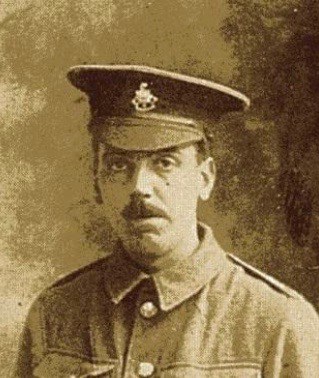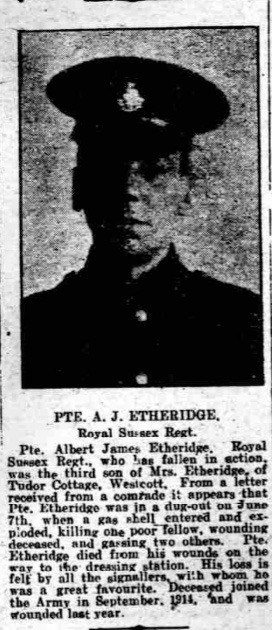
© Westcott LHG
Thank you to Westcott Local History Group for allowing Dorking Museum to publish their First World War research.
Albert James Etheridge was born in Holmwood in 1887, the son of James and Mary Etheridge who later moved to Westcott where they lived in Victoria Road (now Bailey Road). James was a butler who later worked at Netley House, Shere and Albert followed his father into the profession. By 1911 Albert was working at Warninglid Grange in Sussex and it was probably for this reason that he enlisted at Haywards Heath and joined The Royal Sussex Regiment.
Albert served in the 9th (Service) Battalion of the Royal Sussex Regiment which was formed at Chichester in September 1914 as part of Lord Kitchener’s new volunteer Army. After training in the south of England the battalion went to France as part of the 24th Division, landing at Boulogne on 1st September 1915. It was subsequently engaged in the battles at Loos, Delville Wood and Guillemont and in early June 1917 was in readiness for the Battle of Messines.
The German front line ran along the crest of Messines Ridge and the ridge had to be captured before any offensive could be launched in Flanders to achieve the breakthrough needed to win the war. Meticulous planning and preparations preceded the battle and Royal Engineer tunnelling companies, known as ‘clay-kickers’, drove a series of tunnels to place 19 huge mines under the German positions. The battle began on 7th June 1917. After an opening artillery barrage the mines were exploded with devastating effect; the enemy positions were destroyed and some 10,000 German troops are believed to have been killed.
After the explosions, some 80,000 Allied troops advanced in waves under a creeping barrage and soon began to take their objectives. By 7.00 am the ANZAC Corps had captured Messines and progress continued throughout the day. The 9th Royal Sussex, as part of the 24th Division, took part in the final assault to take the village of Oosttaverne. Field Marshal Haig’s Passchendaele Despatch recorded their action in the following paragraph:
‘Half an hour later the other English battalions (24th Division) broke through the enemy’s position. Parties of the enemy surrendered freely, and his casualties were reported to be very heavy. By the evening the Oosttaverne Line had been taken and our objectives had been gained.’
The Battle of Messines lasted from 7th to 14th June 1917 and was one of the greatest Allied successes of the war. But it still came at a heavy cost with 24,500 casualties on the Allied side and 25,000 on the German. The 24th Division’s casualties were relatively light, but they included Albert Etheridge who was a battalion signaller and who died of wounds sustained on the first day of the battle.

PTE. A. J. ETHERIDGE
Royal Sussex Regt.
Pte. Albert James Etheridge, Royal Sussex Regt, who has fallen in action was the third son of Mrs. Etheridge, of Tudor Cottage, Westcott. From a letter received from a comrade it appears that Pte. Etheridge was in a dug-out on June 7th, when a gas shell entered and exploded, killing one poor fellow, wounding deceased, and gassing two others. Pte. Etheridge died from his wounds on the way to the dressing station. His loss is felt by all the signallers, with whom he was a great favourite. Deceased joined the Army in September 1914, and was wounded last year.
Private Albert James Etheridge’s death was reported in the Dorking Advertiser on 14th July 1917, it included a letter from one of the officers to Albert’s parents.
‘I am sorry to say that your son Bert was killed on June 7th. He was in a dugout with four others when a gas shell came right in and exploded; it killed one fellow outright, wounded Bert and gassed two others. Bert succumbed to his wounds on the way to the dressing station. Your loss is felt by all us signals as he was a favourite with us all. They join with me in sending their deepest sympathy to you on the loss of your son. I have been with Bert ever since he was in the Army so you can guess how much I shall miss his companionship.’
Albert Etheridge is buried in the military cemetery at Belgian Battery Corner, located 2 km south west of Ypres, so named because it lies at a road junction where three batteries of Belgian artillery were positioned in 1915.
Although the Battle of Messines cleared the way for the Flanders offensive to take place, this ended in November in stalemate with enormous losses on both sides. One of the casualties was Albert’s brother-in-law, Harry Jeater, who is also remembered on this memorial.
After the war the huge craters left by the mines at Messines were gradually taken back by local farmers. The crater of one mine, at Spanbroekmolen, was purchased by Lord Wakefield. Now known as The Pool of Peace, it has been left as a memorial and is owned and cared for by the Toc-H Museum at Poperinghe.
| Born | Holmwood, Surrey | |
| Son of | James and Mary Etheridge of Victoria Road (now Bailey Road), Westcott | |
| Regiment | 9th Battalion, Royal Sussex Regiment | |
| Number | G/3568 | |
| Date of Death | 7th June 1917 | |
| Place of Death | Messines, Belgium | |
| Cause of Death | Died of wounds | |
| Age | 30 | |
| Cemetery | Belgian Battery Corner Cemetery, near Ypres, Belgium |

